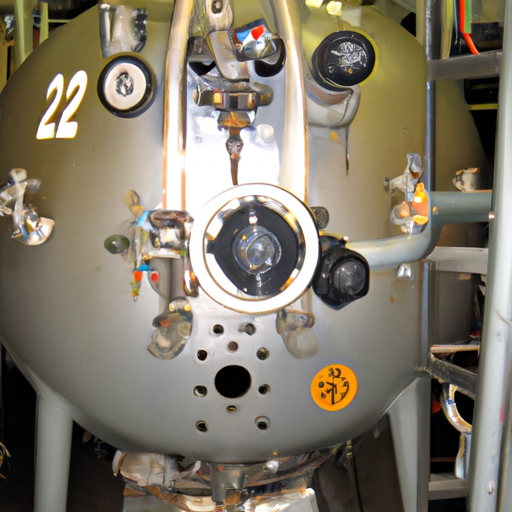Are you tired of constantly dealing with well pump cycling and short-cycling issues? Look no further, as we have the solution for you. In this article, we will explore the causes of well pump cycling and short-cycling, and provide you with practical tips and tricks to effectively deal with these frustrating problems. Say goodbye to constantly stopping and starting well pumps, and say hello to a more efficient and reliable system. So buckle up and get ready to learn how to tackle these issues head-on! Well pump cycling and short-cycling issues can be frustrating and inconvenient, but with the right troubleshooting and solutions, you can effectively address these problems. In this article, we will explore the common causes of well pump cycling, how to troubleshoot these issues, and the steps you can take to prevent them from occurring in the future.

Common Causes of Well Pump Cycling
Insufficient Tank Size
One of the common causes of well pump cycling is an insufficient tank size. If your pressure tank is too small for the water demand in your household, it can lead to frequent cycling as the pump tries to keep up with the demand. This can cause unnecessary wear and tear on the pump and reduce its lifespan.
Waterlogged Pressure Tank
A waterlogged pressure tank occurs when the tank’s air bladder becomes filled with water, causing the pump to cycle more frequently. This can happen due to a malfunctioning air inlet valve or through a gradual process known as waterlogging. When the tank becomes waterlogged, it reduces the available air cushion, leading to increased cycling.
Faulty Pressure Switch
A faulty pressure switch can also contribute to well pump cycling issues. The pressure switch is responsible for monitoring and controlling the water pressure in your system. If it malfunctions or becomes stuck, it can cause the pump to cycle on and off rapidly, leading to short-cycling.
Plumbing Leaks
Plumbing leaks, such as leaking pipes or fixtures, can also result in well pump cycling. When there are leaks in your plumbing system, it can disrupt the water pressure and cause the pump to cycle more frequently as it tries to compensate for the loss of water.
Troubleshooting Well Pump Cycling Issues
If you are experiencing well pump cycling problems, there are several troubleshooting steps you can take to identify and resolve the issues. By following these steps, you can pinpoint the cause of the problem and take appropriate action.
Check and Adjust Pressure Settings
The first step in troubleshooting well pump cycling is to check and adjust the pressure settings. Ensure that the pressure switch is set to the appropriate cut-in and cut-out pressure levels. If the settings are incorrect, adjust them accordingly. The cut-in pressure is the point at which the pump starts, and the cut-out pressure is the point at which the pump shuts off.
Inspect the Pressure Tank
Next, inspect the pressure tank for any signs of waterlogging or damage. Check the tank’s air pressure with a tire pressure gauge to ensure it matches the manufacturer’s recommended pressure. If the air pressure is low, you may need to add more air. If the tank is waterlogged or damaged, it may need to be drained, recharged, or replaced.
Inspect the Pressure Switch
Check the pressure switch for any signs of damage or malfunction. Ensure that the switch is properly connected and functioning correctly. If you suspect a faulty pressure switch, it may need to be tested or replaced.
Check for Plumbing Leaks
Carefully inspect your household plumbing for any signs of leaks. Look for dripping faucets, water stains, or wet areas near pipes or fixtures. If you detect any leaks, it is essential to address them promptly to prevent further cycling issues.
Addressing Insufficient Tank Size
If you determine that an insufficient tank size is the cause of your well pump cycling problems, you will need to assess your water demand and determine the ideal tank size for your household.
Assessing Water Demand
To assess your water demand, consider factors such as the number of people in your household, the number of bathrooms, and the frequency of water usage. Calculate your peak demand by determining the most substantial water usage period in your home and estimating the amount of water needed during that time.
Determining the Ideal Tank Size
Once you have assessed your water demand, you can determine the ideal tank size. Generally, it is recommended to have a pressure tank that can hold at least one to two minutes’ worth of water supply at peak demand. This ensures that the pump does not need to cycle excessively to meet your household’s water needs.
Upgrading the Pressure Tank
If your current pressure tank is inadequate, consider upgrading to a larger tank. Consult a professional to determine the appropriate tank size based on your water demand and specific requirements. Upgrading to a larger tank can help reduce well pump cycling and improve the overall efficiency of your system.
Resolving Waterlogged Pressure Tank
If a waterlogged pressure tank is the root cause of your well pump cycling issues, you will need to take steps to resolve this problem. Here’s what you can do:
Diagnosing Waterlogging
To diagnose waterlogging, start by turning off the power to the pump and opening a faucet to relieve any pressure in the system. Locate the air valve on the pressure tank and carefully remove the cap. If water comes out instead of air, it indicates that the tank is waterlogged.
Draining the Pressure Tank
To drain the pressure tank, attach a hose to the drain valve at the bottom of the tank. Place the other end of the hose in a suitable drainage area, such as a floor drain or outside. Open the drain valve to release the water from the tank. Once the tank is fully drained, close the valve.
Recharging the Tank
To recharge the pressure tank, ensure that the power to the pump is turned off. Use an air compressor with a tire chuck attachment to add air to the tank through the air valve. Refer to the manufacturer’s guidelines for the recommended air pressure. Once the tank is properly pressurized, close the air valve.
Replacing the Pressure Tank
If the pressure tank is old, damaged, or unable to hold air properly, it may need to be replaced. Consult a professional to determine the appropriate size and type of pressure tank for your system. A new pressure tank can help resolve waterlogging issues and improve the performance of your well pump.

Fixing Faulty Pressure Switch
If you suspect a faulty pressure switch is causing your well pump to cycle excessively, you may need to repair or replace the switch. Here’s what you should do:
Understanding the Pressure Switch
Before attempting any repairs, it’s important to have a basic understanding of how the pressure switch works. The pressure switch is designed to monitor the pressure in the system and communicate with the pump to turn it on or off at specific pressure levels.
Testing the Pressure Switch
To test the pressure switch, turn off the power to the pump and disconnect the switch from the electrical circuit. Use a multimeter to check the continuity of the switch at different pressure levels. Consult the manufacturer’s instructions or seek professional assistance for specific guidance on testing your pressure switch model.
Replacing the Pressure Switch
If testing reveals that the pressure switch is faulty or if it is damaged, it will need to be replaced. Consult a professional or refer to the manufacturer’s instructions for guidance on selecting and installing a suitable pressure switch for your well pump system.
Detecting Plumbing Leaks
Plumbing leaks can contribute to well pump cycling issues, so it’s important to detect and address any leaks in your system. Follow these steps to identify and resolve plumbing leaks:
Checking Household Plumbing
Inspect the visible portions of your household plumbing for any signs of leaks. Look for water stains, wet spots, or dripping faucets. Check all exposed pipes, connections, and fixtures, including toilets, sinks, showers, and outdoor faucets.
Identifying Leaks
If you suspect a leak but cannot visually identify its source, you can perform a simple test. Turn off all water-using appliances and fixtures in your home and monitor the water meter for any movement. If you notice the meter still running, it suggests an undetected leak.
Repairing or Replacing Leaking Pipes
Once you have identified a leak, it’s crucial to repair or replace the affected pipes or fixtures promptly. Depending on the severity of the leak, you may be able to fix it yourself with basic plumbing tools and materials. However, complex leaks or significant pipe damage may require professional assistance.

Consequences of Well Pump Short-Cycling
Well pump short-cycling can have adverse effects on your well system’s performance and longevity. Understanding the consequences can highlight the importance of addressing these issues promptly:
Reduced Lifespan of Well Pump
Frequent cycling and short-cycling can put excessive strain on the well pump, leading to premature wear and tear. This can reduce the lifespan of the pump and result in the need for costly repairs or replacement sooner than expected.
Increased Energy Consumption
Short-cycling causes the pump to turn on and off frequently, leading to increased energy consumption. This can result in higher utility bills, wasting both energy and money.
Poor Water Pressure and Flow
Well pump short-cycling can disrupt the water pressure and flow in your home. You may experience reduced water pressure, inconsistent water supply, or inadequate flow, making it difficult to carry out daily tasks such as showering or doing laundry.
Causes of Well Pump Short-Cycling
Understanding the causes of well pump short-cycling can help you pinpoint the root of the problem more effectively. Here are some common factors that contribute to short-cycling:
Inappropriate Pressure Settings
Incorrect pressure settings can cause the pump to turn on and off more frequently than necessary. If the pressure switch is set to the wrong cut-in and cut-out pressure levels, it can lead to short-cycling issues.
Waterlogged Pressure Tank
As mentioned earlier, a waterlogged pressure tank can contribute to both well pump cycling and short-cycling. When the tank’s air cushion is reduced, the pump may cycle excessively to try to maintain proper pressure.
Leaking Pipes or Fixtures
Plumbing leaks, such as leaking pipes or fixtures, can disrupt the water pressure and cause the pump to short-cycle. Additionally, leaks can lead to a decrease in water supply, further exacerbating the cycling issues.
Faulty Pressure Switch
A faulty pressure switch can cause the pump to short-cycle if it fails to accurately monitor and control the pressure in the system. Malfunctioning switches may turn the pump on and off rapidly, resulting in short-cycling.
Troubleshooting Short-Cycling Issues
To troubleshoot well pump short-cycling issues effectively, follow these steps:
Adjusting Pressure Settings
Check the pressure switch settings and ensure they are correctly set. If the settings are incorrect, adjust them to the appropriate cut-in and cut-out pressures. The right pressure settings can help reduce short-cycling problems.
Inspecting the Pressure Tank
Inspect the pressure tank for any signs of waterlogging or damage. Check the air pressure inside the tank and ensure it matches the recommended levels. If the tank is waterlogged or damaged, it may need to be drained, recharged, or replaced.
Checking for Leaks
Thoroughly inspect your household plumbing for any signs of leaks. Look for visible leaks around pipes, connections, and fixtures. Perform a water meter test to identify any hidden leaks. Promptly repair or replace any leaking pipes or fixtures to eliminate short-cycling causes.
Testing or Replacing the Pressure Switch
If you suspect a faulty pressure switch, test it using a multimeter or seek professional assistance for accurate diagnosis. If testing reveals a faulty switch or if the switch is damaged, it will need to be replaced.
Preventing Well Pump Cycling Issues
Preventing well pump cycling issues can help you avoid the inconvenience and potential damage caused by excessive cycling or short-cycling. Follow these preventive measures to maintain a healthy and efficient well system:
Proper Pressure Tank Sizing
Ensure that your pressure tank is appropriately sized for your household’s water demand. Consult a professional to determine the ideal tank size based on factors such as the number of occupants and the peak demand estimation.
Regular Maintenance
Perform regular maintenance on your well system to keep it in optimal condition. This includes monitoring the pressure settings, inspecting the tank for waterlogging, and checking for plumbing leaks. Routine maintenance can detect and address potential issues before they escalate.
Professional Inspection
Schedule periodic professional inspections of your well system to ensure all components are functioning correctly. Well pump specialists can assess the condition of your pump, pressure tank, and other vital parts, providing recommendations and preventive measures.
In conclusion, dealing with well pump cycling and short-cycling issues requires troubleshooting the underlying causes and implementing appropriate solutions. By addressing insufficient tank size, waterlogged pressure tanks, faulty pressure switches, and plumbing leaks, you can enhance the performance and longevity of your well system. Regular maintenance, proper pressure tank sizing, and professional inspections can help prevent these issues in the future. Remember, if you are unsure or uncomfortable with troubleshooting or repair tasks, it’s always best to consult a professional well pump technician for assistance.

